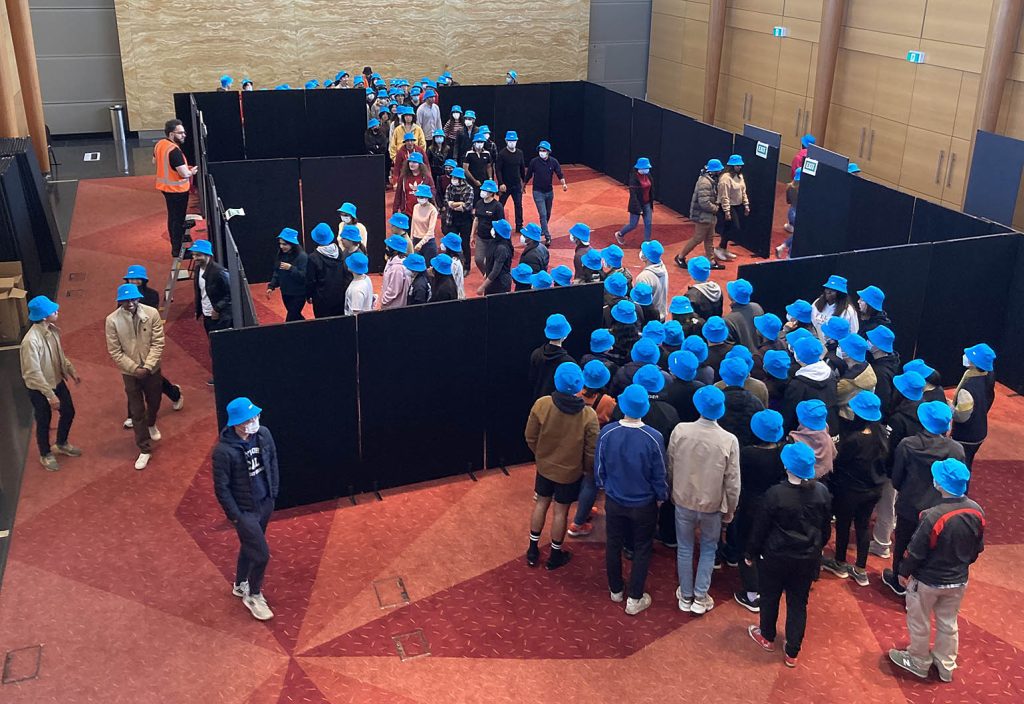Engineers from UNSW Sydney recently carried out a series of experiments to understand how the behaviour of crowds can make the difference in life-or-death situations.
A team of researchers, led by Dr Milad Haghani from the School of Civil and Environmental Engineering, carried out the experiments at UNSW Sydney’s Kensington campus. Over four days, hundreds of volunteers took part in scenarios that tested Haghani’s hypotheses.
In the case of an attack in a crowded space, statistics have shown that the incident usually ends by the time authorities arrive and take control. Within that time period, the response and preparedness of the people involved, what Haghanis refers to as “zero responders”, is the most important determinant of their survival, he says.
“With these experiments we are providing empirical evidence of how training, mental preparedness, awareness and enhanced public knowledge can be effective in disastrous situations such as those in crowded spaces,” says Haghani.
Haghani’s experiments involved placing more than 100 participants into evacuation scenarios, and giving them instructions on how to behave. Sometimes the entire group was asked to behave in the same way – in other experiments, the cohort was split into two groups, with each group given different evacuation strategies.
“As soon as you hit 50 or 60 per cent of the crowd using ‘good’ strategies’, you get the efficiency benefit of that strategy,” explains Haghani. “The remaining people, whether they follow a ‘good’ or ‘bad’ strategy, don’t have a large effect on the overall efficiency of the crowd.
“That was one of the big takeaways from the experiments.”

Changing behaviour instead of architecture
“There isn’t much we can do about the design of an environment to make them more supportive of evacuation,” says Haghani. “Buildings are already built – we can’t make major changes to architecture.”
Haghani argues that mental preparedness, and having the right strategy, will ultimately make the difference to people’s chances of survival.
The effect certain strategies have on evacuation efficiency cannot be achieved through architectural changes, says Haghani.
“No reasonable architectural modification can change the efficiency of evacuation by 50 per cent,” he says. “Whereas in these experiments, we observed that certain strategies can have that effect.”
“There are clear examples of bad architectural design,” continues Haghani, “but if you avoid those, then what else can you do?”
There are certain things that can make a change to the efficiency of an evacuation, however. A number of Haghani’s experiments included the size of exits as a variable.
“To my surprise, we saw that a single two-metre exit, for example, is more efficient than two one-metre exits,” he explains.
Computer modelling vs empirical evidence
The hypotheses that Haghani wanted to test were based on previous computer models that he had built over the course of his eight-year interest in the subject of public safety.
Haghani’s computer models had shown him that changing the strategies that his agents followed made a massive impact on the efficiency of the system. But to test these strategies, he needed to repeat the scenarios using real people.
“I had played with the model to see how we can modify the behaviour of agents in a computer simulation, in order to make the evacuation process more efficient.
“But people would tell me, ‘this is on a computer model – people won’t be able to follow instructions like the computer agent’.
“And that’s correct. A computer agent can follow instructions perfectly. But I believed that real people would be able to follow their instructions too.”
So during the four days of live experiments, Haghani and his team looked at every aspect of people’s behaviour. Every experiment isolated one aspect of decision making, or a physical aspect of their movement, he says.
“We gave them good strategies, and we gave them no strategies. We let them be naive about those strategies. And we also gave them bad strategies with respect to that particular aspect of behaviour,” he says.
Early analysis of the data is already showing positive results, says Haghani. “What we saw was very promising,” he says, “confirming the observations from the computer simulation that as people change their behaviour, their evacuation time and chance of survival can be improved.”
Challenging common knowledge
“The scientific community calls me ‘the empirical guy’ because I don’t stop talking about the importance of empirical data,” says Haghani.
He cites a paper published in Nature that used computer modelling to show that an obstruction placed in front of an exit will improve the efficiency of the flow of people in a heavily crowded environment.
“The computer model was not well calibrated – it’s the kind of computer model I am always critical of,” says Haghani.
“It wasn’t founded on empirical evidence,” he continues. “The paper was called ‘Simulating dynamical features in escape panic’, and it was so influential that its findings have almost turned into a common belief.
“Many researchers had tried to replicate the simulation, but I tried it in an empirical setting, and I was able to show that adding an obstacle either has no effect, or it’s counterproductive.
“Since then another group in Spain has repeated the experiments and confirmed my hypothesis, so the idea is going away in the scientific community, but it’s still there in the minds of the general public.”
What’s next for the research?
Haghani’s research has one overarching aim – to develop a training tool for the public that can make the response of crowds more efficient – ultimately saving lives in times of danger.
He speaks about using school children as a way of sharing information. “If you teach a child something new in school,” he says, “they’ll go home and tell their family.”
“In my previous research I was able to create a computer model that was able to accurately simulate the process of evacuation,” he continues. “But then I thought ‘what are we going to do with that? How can we save lives?’.
“So I shifted my focus. The experiments allow us to create an evidence-based training guideline. The next stage of my research will be to develop these tools and share them, using a variety of media. I want to give this knowledge back to the community.”
For more of the latest engineering news sign up to create’s weekly newsletter.
